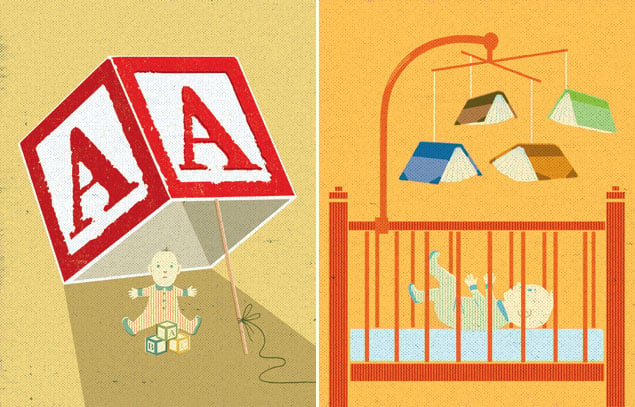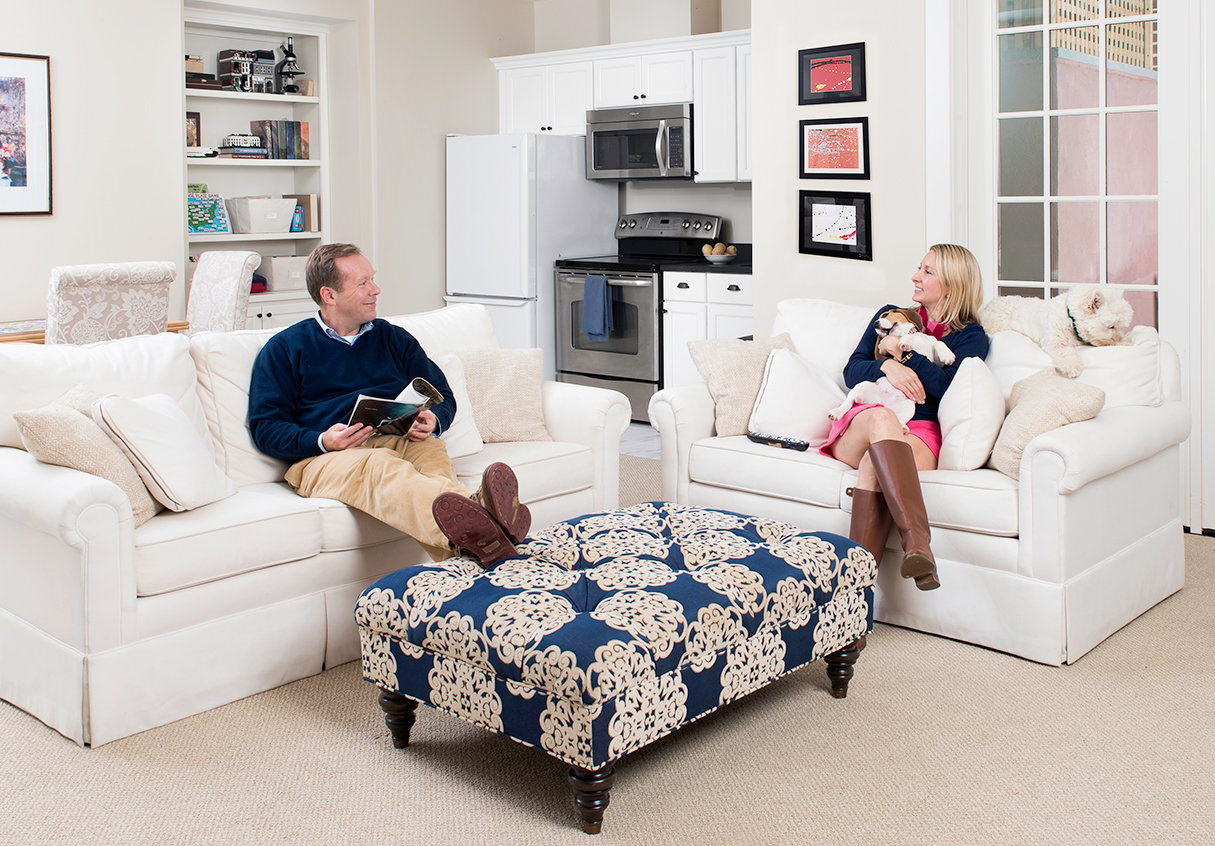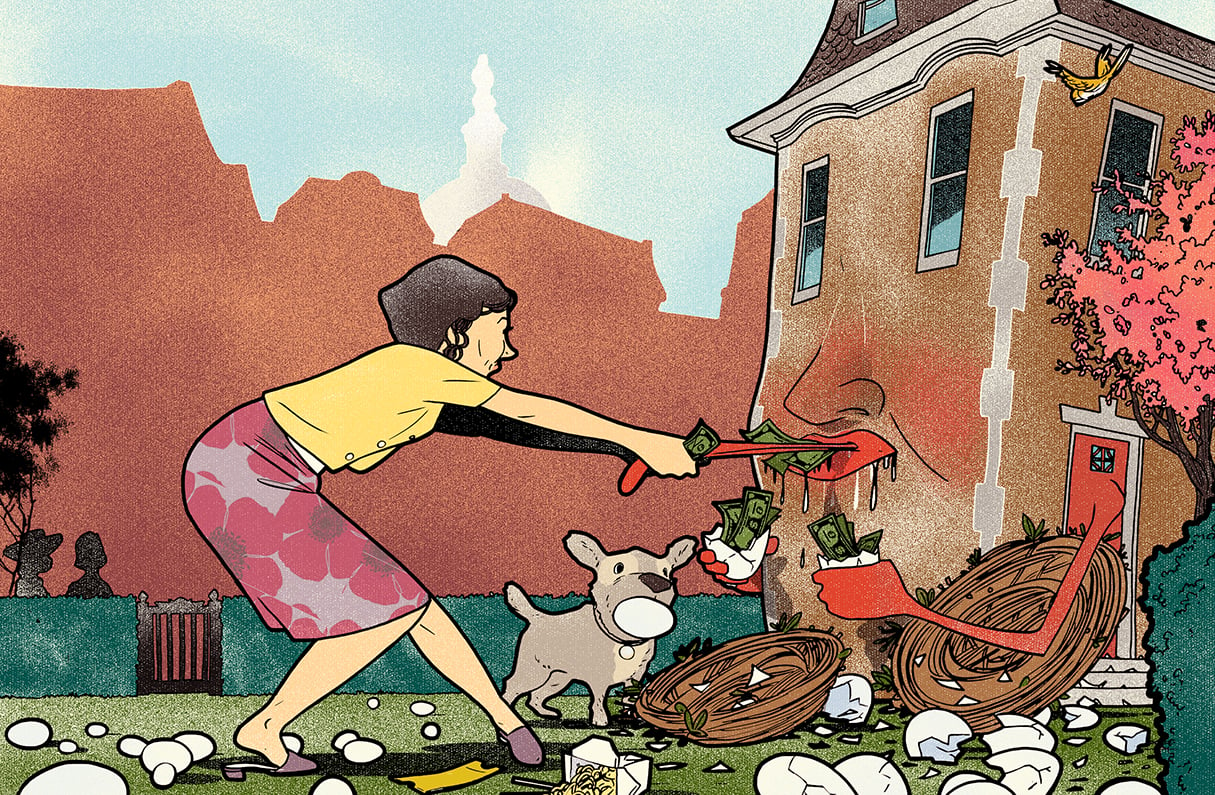I first realized I might be in danger of screwing up my kid while we were finger-painting.
My 20-month-old son, Harper, and I were at the kitchen table. A blank piece of paper was in front of him, and he watched intently as I unwrapped a row of paints in bright colors. I opened the blue, scooped up a blob on my finger, and plopped it onto his paper. Harper stared at it for a moment, then massaged it, karate-chopped it, picked up the paper, and threw it.
“No, no, no,” I told him. “Let’s make something. Watch Mommy. I’m going to make a circle.” Pause. “What is Harper going to make?”
He windshield-wipered his hands across the page. Then he slipped a paint-covered finger into his mouth and smiled. It was a sweet moment.
So why did I feel so frustrated?
I’ve always been an overachiever. I didn’t go to Harvard, but I was obsessed with my career in my twenties. I chased accomplishments–journalism awards, bylines in prestigious magazines–and defined myself by my job as a writer, which made me feel interesting and smart.
Then I had Harper. Suddenly, it was hard to think about anything but the enormous responsibility of raising a child.
I did what American mothers do, especially in high-achieving cities like Washington–I ordered a stack of parenting books: The Happiest Baby on the Block, What to Expect the First Year, Dr. William and Martha Sears’s The Baby Book, and a dozen others. I read them all. I wasn’t just looking for advice on how to get my four-month-old to sleep or how to drop a night feeding. I was thinking long-term. I wanted to get this parenting thing right.
I had Harper on a three-nap schedule at three months old, and thanks to Healthy Sleep Habits, Happy Child, he was sleeping through the night at four months.
I quit my job. I was too worried that Harper might not get the love and stimulation he needed during the eight hours I was gone every day, and we didn’t need my salary.
I enrolled him in a “tummy time” class to help him develop the core muscles necessary for rolling, sitting, and standing. At six months he was shaking bells in a music class, and at nine months he was in a play group. As Harper morphed from cherub-cheeked baby into a svelte toddler, I began teaching him the alphabet, working to stretch his attention span, and planning enriching activities for the week. One of his first words was “go.”
Mom friends and I compared notes like graduate students cramming for midterms: What were the best books for potty training? How did you get your kid to brush his teeth? Eat broccoli? Wear a helmet while riding his tricycle? Did anyone turn her child’s car seat to face forward before he turned two?
We were all trying to do our best. Every generation wants its kids to be happy, and a certain amount of worry comes with the job. But I sensed more than anxiety. As a generation, we sounded like we were crafting a blueprint for raising a better kid. We lamented how little our parents had known about child-rearing–how much they got wrong about discipline (it’s about educating, not yelling!) or safety (our parents let us sleep on our stomachs–the risks!). But mostly, we talked about our kids in terms of development–how we could nudge them ahead to the next set of milestones. (“Your child knows his colors–I heard about these flash cards that might help him learn that the sun is yellow and fire trucks are red.”)
Which brings me back to the finger-painting. If I’m being honest about why that moment haunts me, it’s because I heard an unrecognizable voice coming from within. I didn’t want Harper just to smear the paint around the paper. I wanted to teach him how to draw, and by that I mean help guide his fingers in circles to make, say, wheels on a car.
That’s when it dawned on me: I wasn’t just bringing up baby–I was trying to raise a kid who could finger-paint by age two, learn his letters by three, and speak in complex sentences by four. Not to mention share his toys, eat his veggies, and say please and thank you.
I felt if I could do everything exactly right, Harper would turn out okay–even ahead of the curve.
Much has been written about “helicopter” parents. In a recent article in the Atlantic, “How to Land Your Kid in Therapy,” writer Lori Gottlieb lays out the results of helicopter parenting on the generation of kids now in young adulthood. Time has published “The Backlash Against Overparenting,” and New York magazine published a much-talked-about piece in 2010 about “why parents hate parenting.”
Here’s the thing: I don’t see the parents in those stories at the playground anymore. The upper-middle-class moms at Washington parks today are cut from a slightly different cloth. They hover, but not too much. They’ve read all about the dangers of overparenting and know it’s important to give kids some space. They’re obsessed with their children’s safety but don’t want them to miss out on anything, so they buy things like the Learning Tower, a no-tip kitchen stool with safety walls so kids can help prepare dinner.
Which isn’t to say they’re less involved. Experts tell me that today’s new parents are “enmeshed.” While the helicopter parent is famous for hovering over a child, the enmeshed parent is blurring the line between parent and child altogether.
In certain circles, being a parent means constructing your identity almost entirely around your role as mom or dad. And it’s not just those of us who have left the workforce. Working moms such as Christina Applegate’s character on NBC’s Up All Night also obsess over how much time they spend with their kids, whether their children are on track developmentally, what they are and aren’t doing right as parents.
Many parents replace their Facebook photos with snapshots of their kids, and Applegate’s character wears her daughter Amy’s name on a nameplate around her neck. The message is clear: You are your child and your child is you, which is why parents tie themselves in knots thinking about their kids. Bad behaviors aren’t a reflection of the kid; they’re caused by poor parenting.
You can spot overachiever moms and dads in leafy neighborhoods all around Washington: They pull their kids in $400 Burley bike buggies or carry them in $135 Ergobaby carriers. They hand them $2 pouches of 100-percent-organic fruit-and-veggie purée and read local-mom blogs to find educational events around town: “Story time at Friendship Heights Library at 3 pm.” They begin researching preschools before their child is out of the sleep sack.
These parents read a lot–maybe too much. Thanks to Google, they’ve become part child psychologist, part educator, part pediatrician. They treat the business of parenting so seriously that it can feel like one misstep will put their kid on the train to Loserville.
It starts before birth: “Begin your eating-well campaign even before you conceive and you’ll be doing yourself (and your soon-to-be embryo) a favor,” reads an article on the What to Expect When You’re Expecting website. Later, parents hear they should give kids water (not juice!) in straw cups rather than sippy cups because sucking promotes muscle tone important for speech development. They’ll hear that educational puzzles (by Melissa & Doug!) are better for kids than brain-dead light-up toys. And from hearing other moms talk, they’ll quickly learn that good and bad days are defined by how many vegetables they got their kid to eat.
Research shows that parents today aren’t as happy as those of previous generations. They’re trying so hard to do everything right that they’re losing some of the joy of parenting.
One area couple says that the biggest thing they fight about is their young son: She thinks her husband works too much; he’s determined to land a promotion. What they do agree on: Their two-year-old is going to attend a half-day preschool class in Mandarin next year.
Peter Stearns, a historian at George Mason University and author of Anxious Parents: A History of Modern Childrearing in America, says that 50 years ago parents considered themselves responsible for their children’s physical and emotional health, but parents today have added something else to the list: “They think it’s their job to make sure that their kids feel stimulated and happy at all times.”
But in the quest to build a better child, experts say, today’s moms and dads are losing sight of the bigger picture and mucking up the one thing they’re working so hard to get right: raising a good kid.
Once a month, the teachers at Broad Branch Children’s House, a Montessori preschool in Chevy Chase DC, hold an open house. An energetic 28-year-old teacher named Stacey Band uses the event to talk about her passion for the Montessori program. She tells parents, mostly professionals in their thirties and forties, that even 2½-year-olds want to learn to do things for themselves.
“They don’t want me zipping their coat,” she says. “They don’t want me to unpack their lunch or feed them with a spoon.” A few parents inevitably shift around nervously when she says this.
“Ms. Stacey” tells parents about the different parts of the room: the coat rack where the children hang their coats, the tables where they sit, and the arts space, where a tray on a low shelf holds two pairs of scissors.
She’s prepared for the panic on some parents’ faces when they spot the scissors sitting out in the open. She’s also ready for their questions: “Couldn’t the kids just grab them?” Yes, she says. That’s the point.
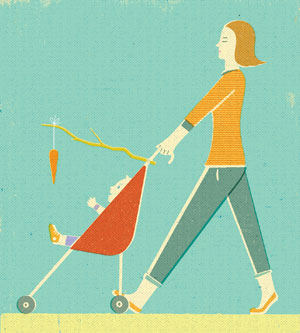
She assures parents that the scissors have rounded edges. That the children are shown how to use them, how to carry them on the tray to their workspace, how to hold them safely. That many children love cutting up scrap paper. That learning to cut with scissors helps improve motor development.
Preschoolers have been cutting with scissors for decades. But Penny Glover, director of development at Metro Montessori, a consortium that includes Broad Branch, says that while young children today know what scissors are, many have never used them before. Which makes them a hot commodity in the classroom.
“Learning to cut with scissors is great for hand/eye coordination,” says Ms. Stacey. “It’s likely that the hand that they’re cutting with is the hand that they’ll later use for writing. I’ve seen children who can read and can work with numbers in the thousands, but when it comes to writing, they struggle because they haven’t developed the fine motor skills required.”
Cutting with scissors, she says, is just as important to fine-motor development as learning to feed and dress yourself. Case in point: DC public schools offer occupational therapy to help kids improve their hand/eye coordination by drawing and cutting with scissors.
So if scissors are good for our kids, why are parents suddenly scared of them?
The answer goes beyond overprotection. Parents are terrified of screwing up. The world has become a scary place–who even wants to listen to the 6 o’clock news anymore? Today’s moms and dads want to control what the kids are exposed to, whom they spend time with, and what they learn.
Sending a child to preschool can be fraught with anxiety because it means parents have to trust someone else with their child. Some preschool administrators joke that teaching kids is the easy part–it’s getting parents to separate that’s hard.
To compensate for the fear that kids can be broken by the world, parents act as a child’s “butler, sherpa, and concierge” well into the teenage years, says Wendy Mogel, a clinical psychologist in Los Angeles and author of The Blessing of a Skinned Knee. They spend hours piecing together a perfect environment: fun and educational, structured and hands-on. They take their kids on airplanes to exotic locales and drag them along to white-tablecloth restaurants to enrich the children’s lives. Who needs to be a pushy helicopter parent if you give your kid the right setting in which to bloom?
Parents almost know too much about raising kids today, and it’s confusing all of us. Historian Peter Stearns says parents in previous generations didn’t have the same access to information–baby boomers read some basic books, then asked their neighbors or parents for advice. In the past, if something was wrong with a child, parents would take a wait-and-see approach. Today they get on the Internet, and they’re diagnosing their child with a developmental delay or illness before they’ve even called the pediatrician.
“As a parent, you research and research, and opinions vary so drastically,” says Kate Jordan-Downs, director of the Easter Seals Child Development Center in DC’s Columbia Heights and mother of a 14-month-old. “You think: If I don’t do it right, I’m not a good parent. There’s so much pressure.”
While there have always been disparate views on parenting, the idea that there’s a right way and a wrong way to raise kids is fairly new. In the past decade, the number of parenting books has grown exponentially, with everyone from the “tiger mother” to an American expat in France (Bringing Up Bébé) sharing their secrets for raising the perfect child. Magazine covers promise “3 Ways to Get Your Kid to Behave!, Focus!, Share!” while ads flash photos of ergonomic strollers, SIDS-resistant swaddles, or DVDs that will help your child learn to read earlier.
The spike in information has led parents to believe that if they just study enough they can come up with a winning approach to parenting. But in trying not to screw up, some well-intentioned parents may be doing more harm than good.
Nowhere is this more evident than in the struggle to get a child to sleep through the night.
Sandra Alboum, an Arlington mother of two, was at her breaking point. In 2009, her two-year-old son, David, insisted on being read to sleep every night and would wake up two or three times before morning. Her nine-month-old, Lauren, preferred to be rocked to sleep and would wake up crying in the middle of the night. Alboum would go into Lauren’s room, feed her an ounce or two of formula, and rock her back to sleep. Her husband, Jonathan, tried to help, but the kids wanted Mommy.
Alboum struggled to stay awake during the day at her translation business; she started writing business checks from her personal account. Friends admitted that “cry it out,” a controversial approach in which parents let children cry themselves to sleep, worked for them, but Alboum couldn’t do it: “Crying stimulates this part of you that says you need to go to them.”
She remembered reading about sleep expert Suzy Giordano in the Washington Post years earlier. Out of desperation, Alboum made an appointment for Giordano to come to her home. Giordano has been helping families sleep-train their babies since 1995.
Before her visit, Giordano told Alboum to take David to the pediatrician to make sure he was well and to pick up a light timer (to indicate when it was time to wake up) and a kitchen timer (to indicate it was time to go to sleep).
The sleep training would work like this: Alboum would read David three books, and when the kitchen timer dinged she’d tell David it was time to go to sleep. Then she’d leave: “I’ll see you tomorrow morning when the light goes on.”
After that, Giordano said, Alboum and her husband should have dinner and relax. “Turn the monitor off,” she said. Giordano would take care of the night wakings, too: “We’re going to teach him that it’s his job to fall asleep and stay asleep.”
David screamed for 45 minutes before he fell asleep the first night. Giordano went to his room three times to reassure him: “David, it’s your job to go to sleep. Mommy will see you tomorrow morning when the light goes on.” After the third time, she left him to fall asleep on his own. He didn’t wake up again that night. Alboum was shocked. “It didn’t kill him,” she said. “He woke up as the happy little boy I know.”
Within a few days, Giordano had both David and Lauren falling asleep on their own, and everyone, including Mom, was sleeping through the night. Giordano’s fee: $2,800. “I would have paid triple,” says Alboum.
A couple of weeks later, Alboum was dropping David off at preschool when she mentioned to a friend that she had worked with a sleep specialist to get David sleeping through the night. When she told her that David cried for 45 minutes on the first night, her friend, whose child was also a poor sleeper, looked horrified. “How could you do that to him?” she said. “How terribly selfish of you.”
Conner Herman is cofounder of Dream Team Baby, a consulting group that helps Washington parents get their kids to sleep, and coauthor of The Dream Sleeper: A Three-Part Plan for Getting Your Baby to Love Sleep.
Many of her clients have been influenced by “attachment parenting,” a philosophy devised by Dr. William Sears that emphasizes the mother/baby bond. It encourages parents to go to the baby each time he or she cries, to co-sleep, to “wear” their infants in carriers, and to achieve a sense of “harmony” with their babies, among other things.
This approach has made women believe they can actually “love” their kids to sleep. They constantly go to them at night, afraid to let them cry for fear of causing long-term emotional damage.
Mothers will get up in the night and nurse, rock, and sing their children back to sleep–which is all considered fine, and a necessary sacrifice, in a baby’s first weeks. But some moms begin to break down as the months or even years pass. They see their own need for sleep as a weakness–they should always be “on” when their baby needs them. Herman has seen desperate mothers sleep in the crib to try to get their child to sleep and still feel loved.
“These poor moms get depressed because they’re up all night,” says Herman. “They’re trying to be the best mom possible, so they feel like they have to put their whole self, all of their energy, into getting the baby back to sleep. But it’s not working. So they end up feeling like failures.”
Parents struggle with letting their babies “cry it out” because they fear that the baby will feel abandoned or that the crying will have a negative effect on the child’s brain, though there’s no conclusive evidence of that. For some, cry-it-out is difficult for a simpler reason: They’re doing something their child doesn’t like, and they’re forced to listen to the response.
“It’s the first set of limits you set for your child, and it can be really hard,” says Herman. Drawing boundaries may be the most important part of parenting, and it’s probably the part parents struggle with most. It can make a parent feel unpopular–an uncomfortable feeling for a generation that, experts say, wants to be friends with its kids.
Herman emphasizes that sleep training is a form of nurturing. “Sleep is an essential life skill,” she says. Parents perk up when they hear this. It’s much easier to accept the crying if it means your kid will sleep okay before high-school midterms 15 years later. Suddenly, you’re not torturing–you’re helping your child.
Jennifer Weaver, a clinical social worker and play therapist with Weaver and Associates in McLean, works with young children across the region. She says parents have become very sophisticated about helping their kids identify their feelings. They’ll say things like “You feel frustrated that you can’t paint right now” or “You feel sad that your friend pushed you.”
All of that is good, she says. Learning to identify an emotion is an important part of development. But then parents want the negative feeling to go away: “You feel frustrated that you can’t paint–well, let’s go to the park!”
“They quickly move from feeling to solution,” says Weaver. “But kids can really benefit when they’re forced to experience an emotion. Otherwise the message is ‘You have an uncomfortable emotion, which is too hard to live with, so let’s quickly find ways to fix it.’ “
That’s a problem because children need to learn to tolerate their feelings–to know how to process anger, sadness, and frustration; otherwise all those emotions can feel the same to them. Plus, learning to deal with emotions lays the foundation for response behaviors such as delayed gratification and impulse control: “I really want to paint, but I have to wait until after my nap.” “I feel like punching that boy, but I’m going to wait until that feeling goes away.”
Kids who don’t learn to cope with negative emotions struggle later. Weaver says about half of the kids she sees are anxious teens. “Someone once told me that anxiety is just another word for unfelt feelings,” she says. “That’s a good way to see it.”
Weaver doesn’t suggest that parents let a kid scream for 30 minutes because he can’t paint. A little distraction is fine, she says, as long as you send the message that the feeling is tolerable. When possible, it might help to let a child “sit” in a negative emotion for 30 seconds to a few minutes. Don’t torture the child–if he’s melting down, go to him. Just don’t go too soon.
“Let them feel it, and wait,” Weaver says. “Research shows that the most successful people weren’t the smartest kids in the class. They were the kids who experienced failure and learned to move beyond it.”
Penny Glover, director of the Metro Montessori consortium, finds that parents get upset if their child is hit or bitten at preschool and often want to change the child’s classroom. Glover reassures parents that the staff intervened right away, that the incident was used as a teachable moment–“Our hands are for holding, not hitting”–and everyone moved on.
“Children shouldn’t be in a bubble,” she tells parents. “It’s better for your child to learn how to deal with a bully rather than just run away.” It’s probably not the last bully the child will encounter in life.
It seems the only area where parents haven’t gone soft is academics, particularly in Washington. Credentials count in this town, and an acceptance letter from certain preschools can make parents giddy with dreams of the Ivy League. And forget finger-painting: Washington nursery schools report that parents want to know when their kids will learn to read.
What’s striking to experts is how early this push toward academics is starting.
Studies show that parents spend more time with their kids than in the 1950s–and that doesn’t mean just being in the same room. They schedule activities together, work on skills in the playroom, invite friends over for play dates. In the early years, many are drawn to academics-driven daycare organizations such as the Goddard School and Crème de la Crème (both of which have local branches); in later years, they enroll their kids in high-cost tutoring programs.
“Some preschool parents ask for homework,” says Metro Montessori’s Glover. When their four-year-olds are learning to read, parents ask if there are workbooks they can bring home. Glover discourages homework: “If you push them to do more work at home, the children may burn out or lose interest.”
A true Montessori program lets children develop at their own pace and on their own terms. When a child is interested in something, intrinsic motivation kicks in–and that’s the key to mastering a skill. “When a parent tries to over-guide, a child is more likely to lose interest,” Glover says.
Some parents get so excited about a child’s academic development that they may push the kid to show a grandmother or neighbor what he or she can do. The adult typically will respond with “Good job!” or “I’m so proud of you.” But child-development experts say it’s not wise to teach a child to do things for praise or reward. They call it “ta-da!” parenting–it makes children believe everything they do is special. That can result in the loss of intrinsic motivation; it’s interesting only if someone is there to clap. “It’s more important that they get that satisfaction from within,” says Glover.
At Metro Montessori, kids can enroll in such extracurricular activities as ballet, art, tae kwon do, and sports. Many parents want their kids in everything, and teachers find themselves encouraging parents to pull back. “It’s tough for parents who are successful and educated to remember that they used to go out and play and didn’t have something planned for every minute of the day,” says Glover. She reminds them that free play and discovery are just as important as learning Spanish.
In fact, at age three, probably more so.
One local preschool director says if a nursery school doesn’t have a serious academic curriculum, it should prepare to go out of business. Direct instruction–flash cards, workbooks, listen-and-learn approaches–is what Washington parents increasingly want. But is it best for kids?
Pediatricians seem alarmed at the push toward academic work in preschool. In 2007, the American Academy of Pediatrics published a report emphasizing the importance of free play to emotional and cognitive development. “Despite the numerous benefits derived from play for both children and parents, time for free play has been markedly reduced for some children,” the report says. “This change may have implications on children’s ability to store new information, because children’s cognitive capacity is enhanced by a clear-cut and significant change in activity.”
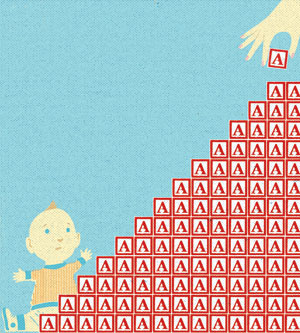
A November 2011 article in Scientific American says that the push toward direct instruction in preschool may have unintended effects. Decades of research prove that learning through experience, or play, is how kids learn best. Last year, Alison Gopnik, a professor of psychology at the University of California, Berkeley, and her colleagues showed two groups of children a toy that played music. One group was shown how to use it by an instructor; with the other group, the instructor pretended she didn’t know how it worked. The children shown what to do simply imitated the instructor. But they didn’t figure out, as the second group did, that there was a more efficient way to get the music to play. The study suggests that children learn better by experimenting than through direct instruction.
Laura Schulz, who studies early-childhood cognition at MIT, reports similar findings. Two groups of children were shown a toy with multiple functions. An instructor showed one group of children that it squeaked, while the others were left to play with the toy. Kids in the second group were more likely to discover that the toy could do multiple things, including squeaking, while many in the first group learned only that the toy could squeak.
Both studies suggest that when kids are left to play, their innate curiosity leads to greater discovery. If they’re shown how to do something, the learning process is hampered. Jake Greenspan–son of legendary child psychiatrist Stanley Greenspan and cofounder of Bethesda’s Floortime Center, where families go for help with developmental, learning, and behavioral challenges–says the push toward academic-based preschool is worrisome: “They get used to being fed information and memorizing it, but they’re not given the opportunity to think.”
Learning to read and do multiplication is an important but small part of intelligence, says Tim Bleecker, who founded the Floortime Center with Greenspan. You can get a child to memorize and spit back the names of countries or Presidents, and it might impress your friends. But the preschool years should be focused on emotional and social development, he says. If you never learn how to sit down and become emotionally engaged in what you’re doing, you might have trouble writing a creative essay or solving math problems later on.
Many parents today think in terms of schedules. We came of age in a hyper-structured environment–scheduling yoga and happy hours in between a 9-to-5 job and earning an MBA–and it’s how we organize our children’s world, too: breakfast, morning activity, lunch, nap, afternoon activity, dinner, bedtime. In the first year, many parents obsess about getting a baby on a nap schedule, a feeding schedule, an activity schedule. Much of this is good. Kids thrive when they know what comes next and can relax into the pattern of the day. But experts say something can be lost when the schedule gets too rigid.
“Parents think kids need this group or this activity, they need this preschool,” says Greenspan. “They really need their parents. They learn so much more from their parents than they ever will from a music or gym class.”
Dan Levy, a pediatrician in Owings Mills and spokesman for the American Academy of Pediatrics, says parents often ask him what they can do to enhance their child’s development.
“I tell them, ‘You can’t rush Mother Nature,’ ” Levy says. He constantly reminds parents that the “humdrum everyday” is exciting for a little child: “It’s just as stimulating to take a child to the mall as it is a music class. There’s no evidence that any of these classes have a positive impact on the average developing child.”
Greenspan recommends that parents keep at least 50 percent of a child’s day unscheduled and encourages them to give a child three 20-minute sessions of free play. Rather than trying to teach your child something, consider yourself a facilitator. If your child is playing with blocks, don’t encourage her to make a castle. “Often the child is happy building a small wall–they’re not ready for the castle yet,” he says. “Play doesn’t have to be productive.” It’s about exploration.
Sometimes less is more in parenting. Read a magazine while you’re in the playroom, says Dr. Levy. A parent’s presence can make children feel secure enough to let their imagination soar. “I tell parents, ‘Excellence doesn’t mean you have to be involved every step of the way and every second of the day,” he says. “It means letting go and letting children make their own mistakes.’ “
While you’re flipping through People, your child might make an important discovery with his blocks.
Looking back to finger-painting with Harper, I realize now that it didn’t matter that he didn’t draw a car–it only mattered that he had a chance to figure the paint out for himself.
Former Washingtonian senior writer Brooke Lea Foster can be reached at brookeleafoster@me.com.
This article appears in the May 2012 issue of The Washingtonian.

